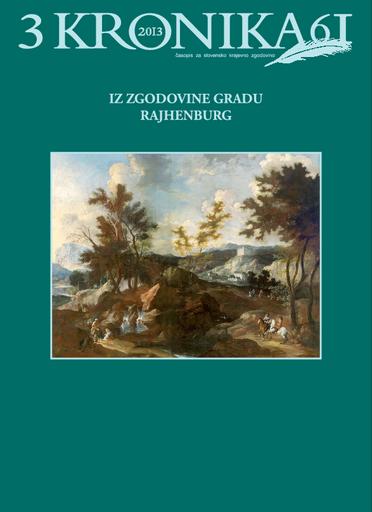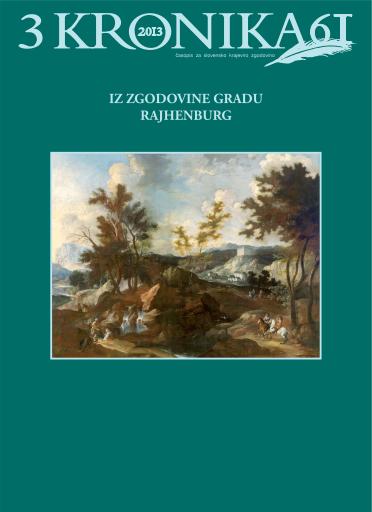/
Serijske publikacije
/
Kronika: časopis za slovensko krajevno zgodovino
Arheološke raziskave na gradu Rajhenburg

Soavtor(ji):Miha Preinfalk (odg. ur.), Barbara Šterbenc Svetina (teh. ur.), Alenka Cizel (prev.), Manca Gašperšič (prev.), Andreja Jankovič Deržič (prev.), Dejan Zadravec (prev.), Lidija Slana (prev.), Meta Osredkar (prev.), Agencija MultiLingual (prev.), Irena Bruckmüller Vilfan (prev.)
Leto:2013
Založnik(i):Zveza zgodovinskih društev Slovenije, Ljubljana
Vir(i):Kronika, 2013, št. 3
Jezik(i):slovenščina
Vrst(e) gradiva:besedilo
Ključne besede:grad, Rajhenburg, Brestanica, arheologija, arheološke najdbe, keramika, pečnice, stavbna zgodovina, antika, romanika, gotika, novi vek, trapisti, renesansa, castle, Reichenburg, Brestanica, archaeology, archaeological finds, ceramics, stove tiles, architectural history, Roman period, Romanesque period, Gothic period, Modern period, Trappists, Renaissance
Avtorske pravice:

To delo avtorjev Maja Bricelj, Nika Veršnik, Maja Lavrič, Robert Krempuš je ponujeno pod Creative Commons Priznanje avtorstva-Nekomercialno-Brez predelav 4.0 Mednarodna
Datoteke (1)

Ime:kronika-2013_3.pdf
Velikost:66.73MB
Format:application/pdf
Stalna povezava:https://hdl.handle.net/11686/file18349
Opis
The gradually built complex of Castle Rajhenburg
was adapted to the morphology of the steep
rocky hill and therefore built on a surface in the
shape of an irregular polygon. Based on the findings
of the latest research, which revealed the location of
the entrance into the Romanesque castle, it can be said that the ground plan of the castle was already
defined by its original design. Investigations in the
vestibule revealed that the entrance was almost in
the same place as the entrance with a preserved
Renaissance portal is today. The threshold of the
Romanesque gate was discovered 2,5 m to the
south, inside the vestibule. It was built into the
paved walking surface and delimited by two buildings,
one on the east and one on the west side.
The walking surface of the Romanesque entry and
the courtyard was paved with large flagstones bound
with mortar. Stratigraphic relations clearly indicate
that the pavement was created together with the
two flanking edifices built in the Romanesque
technique, the small gate tower and a later
demolished building to the West. According to the
small finds, the original entrance with pavement
was in use at least until the late Gothic period. The
still existing building east of the vestibule was once
interpreted as a small gate tower added in the 17th
century. The latest research, however, indicates that
it was built in the Romanesque period. Another
new discovery is a semicircular portal that led into
the northwestern tower (p6) trough its south wall.
It was accompanied by a construction of flagstones
and mortar, probably a remainder of a low staircase.
The location of the Romanesque entrance into the
palas was revealed when a test trench was excavated
in the narrow passage between the northern palas
wall and the Renaissance staircase, which leads to
the arcades of the courtyard (p23). There, a semicircular
Romanesque portal was discovered in the
northern wall of the palas, moved westwards from
the axis of the palas. The portal was walled in
before the vaulting of the palas – which was probably
connected with the rearrangement of floor levels
in the entire complex.
In the Renaissance period, probably soon after
1600, the castle was thoroughly rebuilt: arcades
were built in the courtyard, and floor levels in different
parts of the complex were probably rearranged
and unified. An extension (p2) was built
against the southern wall of the Romanesque tower,
east of the gate (p3). The building to the West,
between the northwestern tower and the gate, was
removed and replaced with a new one (p4-p5). In
the newly constructed building west of the vestibule
(p4-p5), the foundation of a stone spiral staircase
was documented.
It was certainly then that a new semicircular
rusticated portal with the coat of arms of the Gall-
Gallenstein family on the headstone was constructed.
While the entrance to the castle is in the
axis of the original entrance, the portal was moved
nearly 2,5 m to the north, and raised for about 1 m.
The gradient of the terrain in the interior courtyard
was thus eased. The portal could be raised because
the level of the outer castle ward was raised as well,
and that was made possible because at the same
time a bridge was built across the moat.
The castle courtyard was dug up several times in
the past; at first due to pavings and rain drainage,
later also because of different infrastructural conduits.
During the 2011–2012 investigations, we traced
these excavations, which were especially dense
in the vestibule area. In the western part of the
courtyard the rock basis is very high and it slopes
down towards the entrance. The consequence is
that the majority of drainage channels led into the
moat. In the central part, several channels made of
stones and bricks were documented. They led into
the castle cistern and are associated with the time
when the Trappist monks occupied the castle and
the well no longer had its function. In the outer
ward area – in the moat, northwest from the bridge,
foundations of 19th century buildings were documented
under thick layers of fills and levelling deposits.
On the southwestern side, the position of
rock basis and a walking surface from the time of
the Trappist monastery were documented. Also two
walls, parallel to the moat, were discovered. They
were constructed together with the bridge (after
1600, the time of the construction of the entrance
portal). They were probably parapet walls, enclosing
the relatively deep moat.
Metapodatki (12)
- identifikatorhttps://hdl.handle.net/11686/35003
- naslov
- Arheološke raziskave na gradu Rajhenburg
- Archaeological investigations at the Rajhenburg castle
- ustvarjalec
- Maja Bricelj
- Nika Veršnik
- Maja Lavrič
- Robert Krempuš
- soavtor
- Miha Preinfalk (odg. ur.)
- Barbara Šterbenc Svetina (teh. ur.)
- Alenka Cizel (prev.)
- Manca Gašperšič (prev.)
- Andreja Jankovič Deržič (prev.)
- Dejan Zadravec (prev.)
- Lidija Slana (prev.)
- Meta Osredkar (prev.)
- Agencija MultiLingual (prev.)
- Irena Bruckmüller Vilfan (prev.)
- predmet
- grad, Rajhenburg
- Brestanica, arheologija
- arheološke najdbe
- keramika
- pečnice
- stavbna zgodovina
- antika
- romanika
- gotika
- novi vek
- trapisti
- renesansa
- castle
- Reichenburg
- Brestanica
- archaeology
- archaeological finds
- ceramics
- stove tiles
- architectural history
- Roman period
- Romanesque period
- Gothic period
- Modern period
- Trappists
- Renaissance
- opis
- Pri arheološki spremljavi gradbenih posegov ob prenovi gradu Rajhenburg v letih 2011 in 2012 smo dokumentirali različne ostaline, ki osvetljujejo sosledje stavbne zgodovine raščenega gradu, od sledov gradbenih dejavnosti do drobnih najdb. Najpomembnejše odkritje je gotovo prvotni vhod s pripadajočim tlakovanjem, ki je v romanski obodni grad vodil v osi današnje vhodne veže. Na vzhodu je bil varovan z izstopajočim obvhodnim stolpom, doslej pripisovanim 17. stoletju, zahodno od njega pa je stal doslej neznan objekt. Odkrit je bil tudi prvotni vhod v romanski palacij ter sledovi prezidav v renesančno rezidenco in pozneje v trapistovski samostan. Z izjemo redkih rimskih najdb, domnevana predkonradinska faza gradu v arheološkem zapisu ni prisotna.
- During the archaeological supervision of renovation works at Castle Rajhenburg in 2011 and 2012, various remains were documented, from traces of construction works to small finds. They shed light on the architectural history of the castle. The most important discovery is undoubtedly the original entrance with the associated pavement, which led into the Romanesque walled castle in the axis of the present vestibule. To the east, the castle was guarded by a protruding gate tower, which was until now attributed to the 17th century. West of it, a so far unknown building has been found. The original entrance into the Romanesque dwelling quarters (palas) has been discovered, as well as traces of rebuilding, when the castle was redesigned into a Renaissance mansion and later into a Trappist monastery. With the exception of a few sparse Roman finds, a supposed construction phase preceding the erection of the castle under Archbishop Conrad I of Salzburg (1106–1147) does not appear in the archaeological record.
- The gradually built complex of Castle Rajhenburg was adapted to the morphology of the steep rocky hill and therefore built on a surface in the shape of an irregular polygon. Based on the findings of the latest research, which revealed the location of the entrance into the Romanesque castle, it can be said that the ground plan of the castle was already defined by its original design. Investigations in the vestibule revealed that the entrance was almost in the same place as the entrance with a preserved Renaissance portal is today. The threshold of the Romanesque gate was discovered 2,5 m to the south, inside the vestibule. It was built into the paved walking surface and delimited by two buildings, one on the east and one on the west side. The walking surface of the Romanesque entry and the courtyard was paved with large flagstones bound with mortar. Stratigraphic relations clearly indicate that the pavement was created together with the two flanking edifices built in the Romanesque technique, the small gate tower and a later demolished building to the West. According to the small finds, the original entrance with pavement was in use at least until the late Gothic period. The still existing building east of the vestibule was once interpreted as a small gate tower added in the 17th century. The latest research, however, indicates that it was built in the Romanesque period. Another new discovery is a semicircular portal that led into the northwestern tower (p6) trough its south wall. It was accompanied by a construction of flagstones and mortar, probably a remainder of a low staircase. The location of the Romanesque entrance into the palas was revealed when a test trench was excavated in the narrow passage between the northern palas wall and the Renaissance staircase, which leads to the arcades of the courtyard (p23). There, a semicircular Romanesque portal was discovered in the northern wall of the palas, moved westwards from the axis of the palas. The portal was walled in before the vaulting of the palas – which was probably connected with the rearrangement of floor levels in the entire complex. In the Renaissance period, probably soon after 1600, the castle was thoroughly rebuilt: arcades were built in the courtyard, and floor levels in different parts of the complex were probably rearranged and unified. An extension (p2) was built against the southern wall of the Romanesque tower, east of the gate (p3). The building to the West, between the northwestern tower and the gate, was removed and replaced with a new one (p4-p5). In the newly constructed building west of the vestibule (p4-p5), the foundation of a stone spiral staircase was documented. It was certainly then that a new semicircular rusticated portal with the coat of arms of the Gall- Gallenstein family on the headstone was constructed. While the entrance to the castle is in the axis of the original entrance, the portal was moved nearly 2,5 m to the north, and raised for about 1 m. The gradient of the terrain in the interior courtyard was thus eased. The portal could be raised because the level of the outer castle ward was raised as well, and that was made possible because at the same time a bridge was built across the moat. The castle courtyard was dug up several times in the past; at first due to pavings and rain drainage, later also because of different infrastructural conduits. During the 2011–2012 investigations, we traced these excavations, which were especially dense in the vestibule area. In the western part of the courtyard the rock basis is very high and it slopes down towards the entrance. The consequence is that the majority of drainage channels led into the moat. In the central part, several channels made of stones and bricks were documented. They led into the castle cistern and are associated with the time when the Trappist monks occupied the castle and the well no longer had its function. In the outer ward area – in the moat, northwest from the bridge, foundations of 19th century buildings were documented under thick layers of fills and levelling deposits. On the southwestern side, the position of rock basis and a walking surface from the time of the Trappist monastery were documented. Also two walls, parallel to the moat, were discovered. They were constructed together with the bridge (after 1600, the time of the construction of the entrance portal). They were probably parapet walls, enclosing the relatively deep moat.
- založnik
- Zveza zgodovinskih društev Slovenije
- datum
- 2013
- tip
- besedilo
- jezik
- Slovenščina
- jeDelOd
- pravice
- licenca: ccByNcNd
